Research on Population-Land-Industry Relationship Pattern in Underdeveloped Regions: Gansu Province of Western China as an Example
Abstract
1. Introduction
2. Overview of Study Region
3. Research Methods and Data Sources
3.1. Research Methods
3.1.1. Constructing an Index System of Population-Land-Industry Urbanization
3.1.2. Constructing a Model for Evaluating Coordination of Population-Land-Industry Urbanization
3.1.3. Local Spatial Autocorrelation
3.1.4. Pearson Correlation Analysis
3.1.5. Identifying Urbanization Pattern
3.2. Data Sources
4. Results
4.1. Temporal-Spatial Patterns of PUi, LUi, and IUi
4.1.1. Temporal Pattern of PUi, LUi, and IUi
4.1.2. Spatial Pattern of PUi, LUi, and IUi
4.2. The coupling Relationship among PUi, LUi, and IUi
4.2.1. Temporal Pattern of Coupling Relationship among PUi, LUi, and IUi
4.2.2. Spatial Pattern of Coupling Relationship among PUi, LUi, and IUi
4.3. Mutual Feedback among PUi, LUi, IUi, and C
4.4. Spatiotemporal Variation of Urbanization Pattern
4.4.1. Temporal Variation of Urbanization Pattern
4.4.2. Spatial Variation of Urbanization Pattern
5. Discussion
6. Conclusions
Author Contributions
Funding
Acknowledgments
Conflicts of Interest
References
- Chen, M.X.; Liu, W.D.; Tao, X.L. Evolution and assessment on China′s urbanization 1960–2010: Under-urbanization or over-urbanization? Habitat Int. 2013, 38, 25–33. [Google Scholar] [CrossRef]
- Guan, X.L.; Wei, H.K.; Lu, S.S.; Su, H.J. Assessment on the urbanization strategy in China: Achievements, challenges and reflections. Habitat Int. 2018, 71, 97–109. [Google Scholar] [CrossRef]
- Zheng, W.; Walsh, P.P. Economic growth, urbanization and energy consumption—A provincial level analysis of China. Energy Econ. 2019, 80, 153–162. [Google Scholar] [CrossRef]
- Ye, Y.M. The Road of Chinese Urbanization: Economic Support and Institutional Innovation; The Commercial Press: Beijing, China, 2001; pp. 197–198. [Google Scholar]
- Ma, L.B.; Cheng, W.J.; Qi, J.H. Coordinated evaluation and development model of oasis urbanization from the perspective of new urbanization: A case study in Shandan County of Hexi Corridor, China. Sustain. Cities Soc. 2018, 39, 78–92. [Google Scholar] [CrossRef]
- Zhang, P.; Qin, G.; Wang, Y. Optimal Maintenance Decision Method for Urban Gas Pipelines Based on as Low as Reasonably Practicable Principle. Sustainability 2019, 11, 153. [Google Scholar] [CrossRef]
- Cui, X.G.; Fang, C.L.; Liu, H.M.; Liu, X.F. Assessing sustainability of urbanization by a coordinated development index for an Urbanization-Resources-Environment complex system: A case study of Jing-Jin-Ji region, China. Ecol. Indic. 2019, 96, 383–391. [Google Scholar] [CrossRef]
- Friedmann, J. Four theses in the study of China’s urbanization. Int. J. Urban Reg. 2006, 30, 440–451. [Google Scholar] [CrossRef]
- Lu, D.D.; Yao, S.M.; Li, G.P.; Liu, H.; Gao, X.L. Comprehensive analysis of the urbanization process based on China’s conditions. Econ. Geogr. 2007, 27, 883–887. [Google Scholar]
- Li, Y.H.; Jia, L.R.; Wu, W.H.; Yan, J.Y.; Liu, Y.S. Urbanization for rural sustainability–Rethinking China’s urbanization strategy. J. Clean. Prod. 2018, 178, 580–586. [Google Scholar] [CrossRef]
- Ma, W.Q.; Jiang, G.H.; Li, W.Q.; Zhou, T. How do population decline, urban sprawl and industrial transformation impact land use change in rural residential areas? a comparative regional analysis at the peri-urban interface. J. Clean. Prod. 2018, 205, 76–85. [Google Scholar] [CrossRef]
- Cai, Y.Y.; Selod, H.; Steinbuks, J. Urbanization and land property rights. Reg. Sci. Urban Econ. 2018, 70, 246–257. [Google Scholar] [CrossRef]
- Zhou, T.; Jiang, G.H.; Zhang, R.J.; Zheng, Q.Y.; Ma, W.Q.; Zhao, Q.L.; Li, Y.L. Addressing the rural in situ urbanization (RISU) in the Beijing–Tianjin–Hebei region: Spatio-temporal pattern and driving mechanism. Cities 2018, 75, 59–71. [Google Scholar] [CrossRef]
- Henderson, V. The Urbanization Process and Economic Growth: The So-What Question. J. Econ. Growth 2003, 8, 47–71. [Google Scholar] [CrossRef]
- Jabareen, Y.R. Sustainable Urban Forms Their Typologies, Models, and Concepts. J. Plan. Educ. Res. 2016, 26, 38–52. [Google Scholar] [CrossRef]
- He, C.F.; Chen, T.M.; Mao, X.Y.; Zhou, Y. Economic transition, urbanization and population redistribution in China. Habitat Int. 2016, 51, 39–47. [Google Scholar] [CrossRef]
- Brown, D.L.; Kulcsar, C.L.J. Micropolitan areas and the measurement of American urbanization. Popul. Res. Policy Rev. 2004, 23, 399–418. [Google Scholar] [CrossRef]
- Das, S.; Majumder, M.; Roy, D.; Mazumdar, A. Determination of Urbanization Impact on Rain Water Quality with the Help of Water Quality Index and Urbanization Index. In Impact of Climate Change on Natural Resource Management; Jana, B., Majumder, M., Eds.; Springer: Dordrecht, The Netherlands, 2010. [Google Scholar] [CrossRef]
- Hirotsugu, U.; Andrew, N. Agglomeration Index towards a New Measure of Urban Concentration; WIDER Working Paper Series 029; United Nations University World Institute for Development Economic Research (UNU-WIDER): Tokyo, Japan, 2010. [Google Scholar]
- Gu, C.; Li, Y.; Han, S.S. Development and transition of small towns in rural china. Habitat Int. 2015, 50, 110–119. [Google Scholar] [CrossRef]
- Xu, Q.R.; Zheng, X.Q.; Zheng, M.R. Do urban planning policies meet sustainable urbanization goals? A scenario-based study in Beijing, China. Sci. Total Environ. 2019, 670, 498–507. [Google Scholar] [CrossRef] [PubMed]
- Shang, J.S.; Li, P.F.; Li, L.; Chen, Y. The relationship between population growth and capital allocation in urbanization. Technol. Forecast. Soc. 2018, 135, 249–256. [Google Scholar] [CrossRef]
- Cao, G.Z.; Bian, X.; Liu, T. Comprehensive evaluation of the urbanization level in Yangtze River Delta Region: An index frame work based on the population, economic structure and land use. Geogr. Res. 2011, 30, 2139–2149. [Google Scholar]
- Yang, R.; Liu, Y.S.; Long, H.L. The study on non-agricultural transformation co-evolution characteristics of “population-land-industry”: Case study of the Bohai Rim in China. Geogr. Res. 2015, 34, 475–486. [Google Scholar]
- Shen, L.Y.; Ochoa, J.J.; Shah, M.N.; Zhang, X. The application of urban sustainability indicators–a comparison between various practices. Habitat Int. 2011, 35, 17–29. [Google Scholar] [CrossRef]
- Zhao, D.X.; He, B.J.; Johnson, C.; Mou, B. Social problems of green buildings: From the humanistic needs to social acceptance. Renew. Sustain. Energy Rev. 2015, 51, 1594–1609. [Google Scholar] [CrossRef]
- Li, T.T.; Long, H.L. Analysis of rural transformation development from the viewpoint of “population-land-industry”: The case of Shandong province. Econ. Geogr. 2015, 35, 149–155. [Google Scholar]
- Wang, Y.; Fang, C.L.; Wang, Z.B. The study on comprehensive evaluation and urbanization division at county level in China. Geogr. Res. 2012, 31, 1306–1316. [Google Scholar]
- Bugliarello, G. Urban sustainability: Dilemmas, challenges and paradigms. Technol. Soc. 2006, 28, 19–26. [Google Scholar] [CrossRef]
- Wang, H.X.; Xu, J.L.; Sheng, L.X. Study on the comprehensive utilization of resources city kitchen waste in China. Energy 2019, 173, 263–277. [Google Scholar] [CrossRef]
- Tan, Y.T.; Xu, H.; Zhang, X.L. Sustainable urbanization in China: A comprehensive literature review. Cities 2016, 55, 82–93. [Google Scholar] [CrossRef]
- He, B.J.; Zhao, D.X.; Zhu, J.; Darko, A.; Gou, Z.H. Promoting and implementing urban sustainability in China: An integration of sustainable initiatives at different urban scales. Habitat Int. 2018, 82, 83–93. [Google Scholar] [CrossRef]
- The Standardization Administration of the People’s Republic of China. Current Land Use Condition Classification, (GB/T21010-2007); China Zhijian Publising House: Beijing, China, 2007.
- Sun, P.J.; Ding, S.B.; Xiu, C.L.; Wei, Z. Population-Economy-Space Urbanization of Northeast China. Sci. Geogr. Sin. 2012, 32, 450–457. [Google Scholar]
- Li, E.L.; Cui, Z.Z. Coupling Coordination Between China’s Regional Innovation Capability and Economic Development. Sci. Geogr. Sin. 2018, 38. Available online: http://en.cnki.com.cn/Article_en/CJFDTotal-DLKX201809003.htm (accessed on 24 April 2019).
- Cao, W.L.; Zhang, X.L.; Pan, Y.Y.; Zhang, C.M. Coordinate development among population, land and economy urbanization in developed area: The case of Jiangsu province. Chin. Popul. Resour. Environ. 2012, 22, 141–146. [Google Scholar]
- Yao, L.J. Industry Cluster and the Research on the Development of Urbanization Gansu; Northwest Normal University: Lanzhou, China, 2007. [Google Scholar]
- Wang, L.J.; Dong, X.F.; Liu, X.G. Spatio-temporal characteristics of coupling coordination between the quality of population urbanization: The case of 12 central cities in Gansu Province, China. J. Appl. Ecol. 2016, 27, 3335–3343. [Google Scholar]
- Han, X.; Wu, P.L.; Dong, W.L. An analysis on interaction mechanism of urbanization and industrial structure evolution in Shandong, China. Procedia Environ. Sci. 2012, 13, 1291–1300. [Google Scholar] [CrossRef]
- Topel, R. Labor Markets and Economic Growth. Handb. Labor Econ. 1999, 3, 2943–2984. [Google Scholar]
- Henderson, V. Externalities and industrial development. J. Urban Econ. 1997, 42, 449–470. [Google Scholar] [CrossRef]
- Liu, Y.S.; Lu, S.S.; Chen, Y.F. Spatio-temporal change of urban-rural equalized development patterns in china and its driving factors. J. Rural Stud. 2013, 32, 320–330. [Google Scholar] [CrossRef]
- Yang, Y.Y.; Liu, Y.S.; Li, Y.R.; Li, J.T. Measure of urban-rural transformation in Beijing-Tianjin-Hebei region in the new millennium: Population-land-industry perspective. Land Use Policy 2018, 79, 595–608. [Google Scholar] [CrossRef]
- Long, H.L.; Qu, Y. Land use transitions and land management: A mutual feedback perspective. Land Use Policy 2018, 74, 111–120. [Google Scholar] [CrossRef]
- Chen, W.; Shen, Y.; Wang, Y.N. Evaluation of economic transformation and upgrading of resource-based cities in Shaanxi province based on an improved TOPSIS method. Sustain. Cities Soc. 2018, 37, 232–240. [Google Scholar] [CrossRef]
- Wei, S.Q.; Chen, J.F. Land Use Pattern Change in the Process of Rural Urbanization in Jinjiang City of Fujian Province. Res. Sci. 2004, 26, 111–118. [Google Scholar]
- Chen, X.Y. Spatial Structure Reorganization of Hengyang City Based on Interaction Between Urban and Rural Area—Theory and Practice. Sci. Geogr. Sin. 2005, 25, 3288–3293. [Google Scholar]
- Chen, X.Y.; Gu, C.L. Adjustment of Industrial and Spatial Structure of Fujian Province on the Basis of Interaction Between Taiwan and Fujian Provinces. Sci. Geogr. Sin. 2003, 23, 414–421. [Google Scholar]
- Bian, X.; Chen, H.Y.; Cao, G.Z. Patterns of regional urbanization and its implications: An empirical study of the Yangtze River Delta region. Geogr. Res. 2013, 32, 2281–2291. [Google Scholar]
- Jiang, Y.; Wu, D.T.; Yang, H.; Yue, X.Y. Research on regional models of balancing urban and rural development. Urban Stud. 2011, 18, 42–47, 93. [Google Scholar]
- Long, H.L.; Heilig, G.K.; Li, X.B.; Zhang, M. Socio-economic development and land-use change: Analysis of rural housing land transition in the transect of the Yangtse river, China. Land Use Policy 2007, 24, 141–153. [Google Scholar] [CrossRef]
- Cheng, Y. Trends and Policies of “Floating Population” in the Context of Healthy Urbanization. Econ. Geogr. 2012, 32. Available online: http://en.cnki.com.cn/Article_en/CJFDTotal-JJDL201204005.htm (accessed on 22 April 2019).
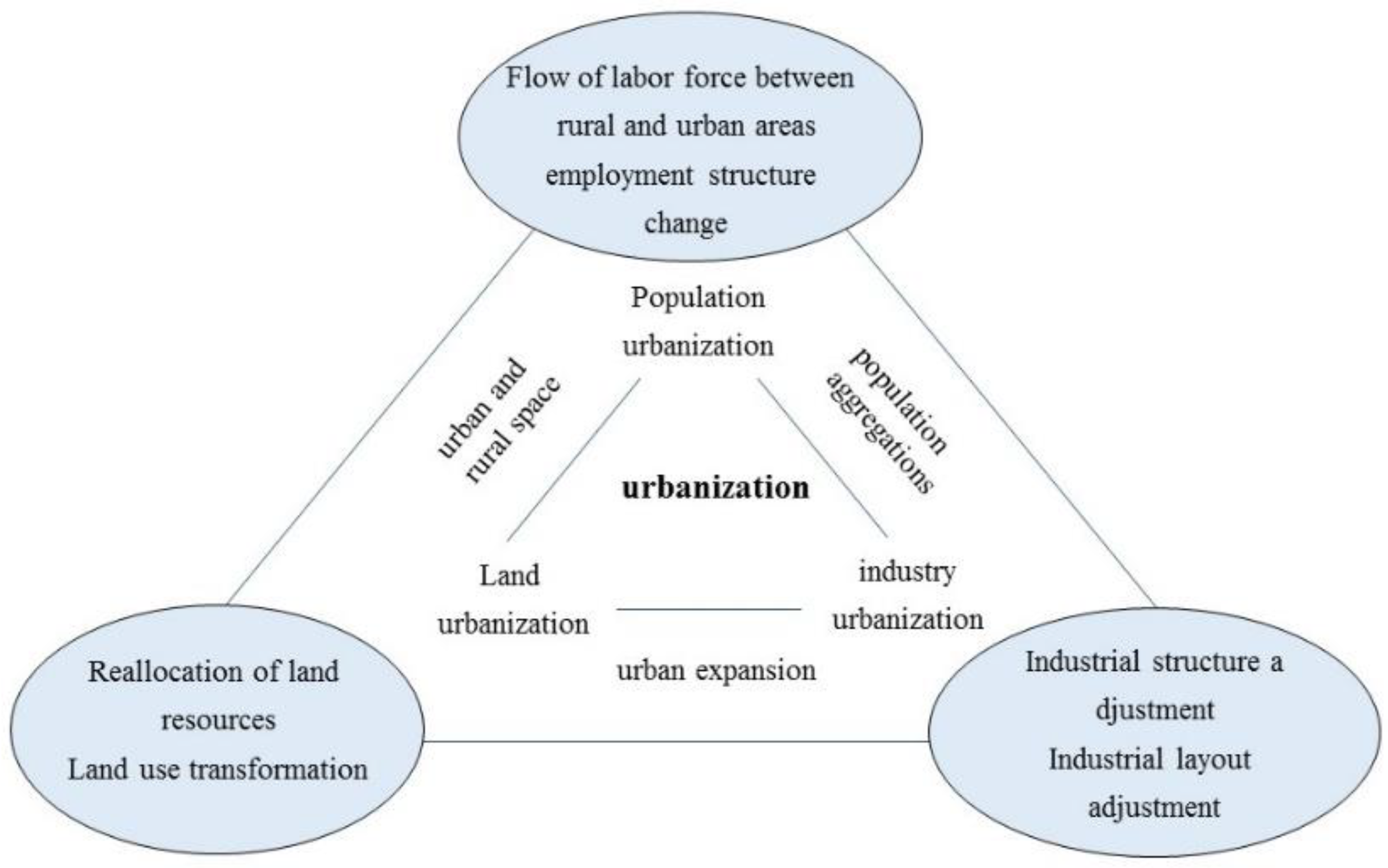
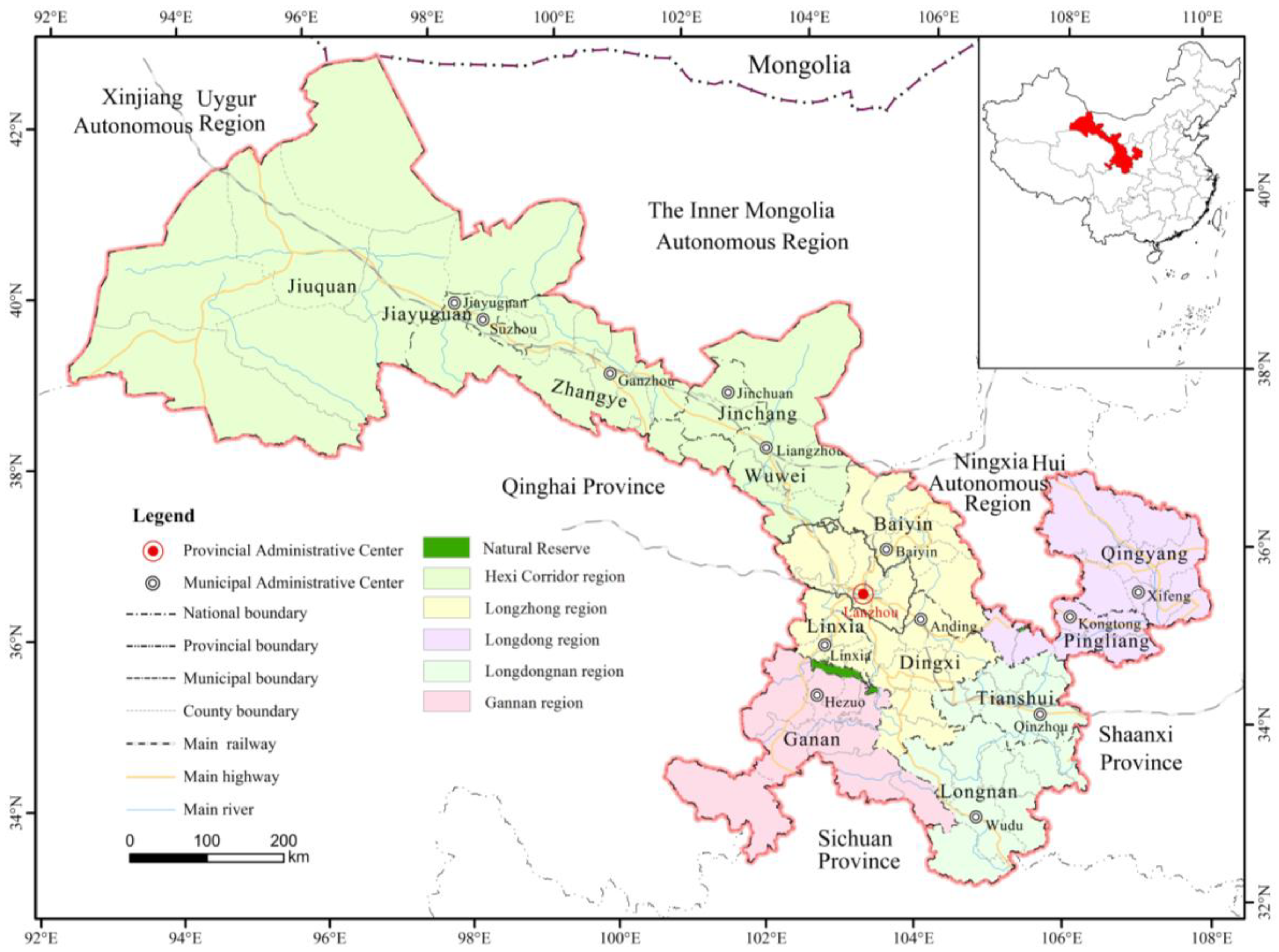

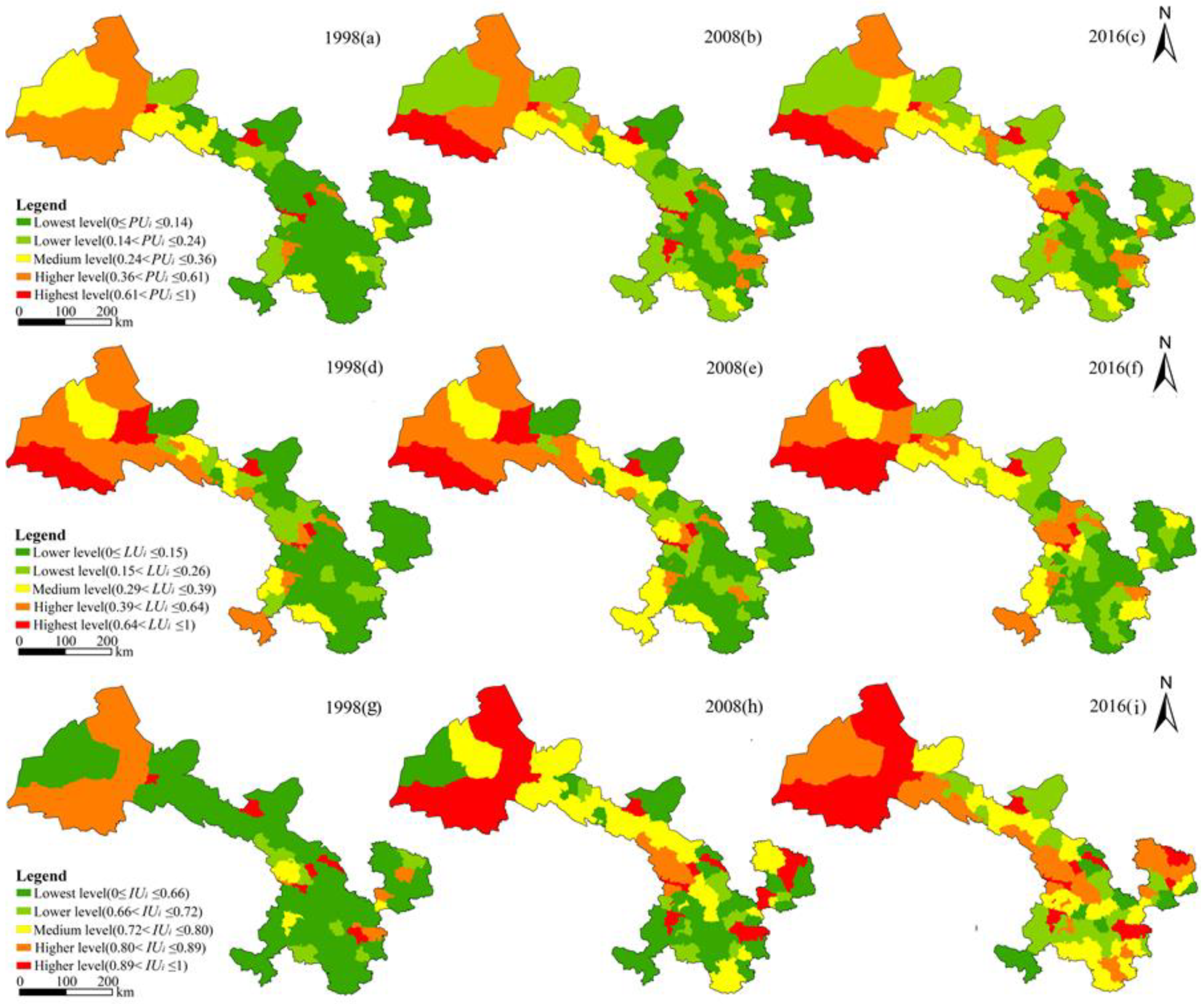
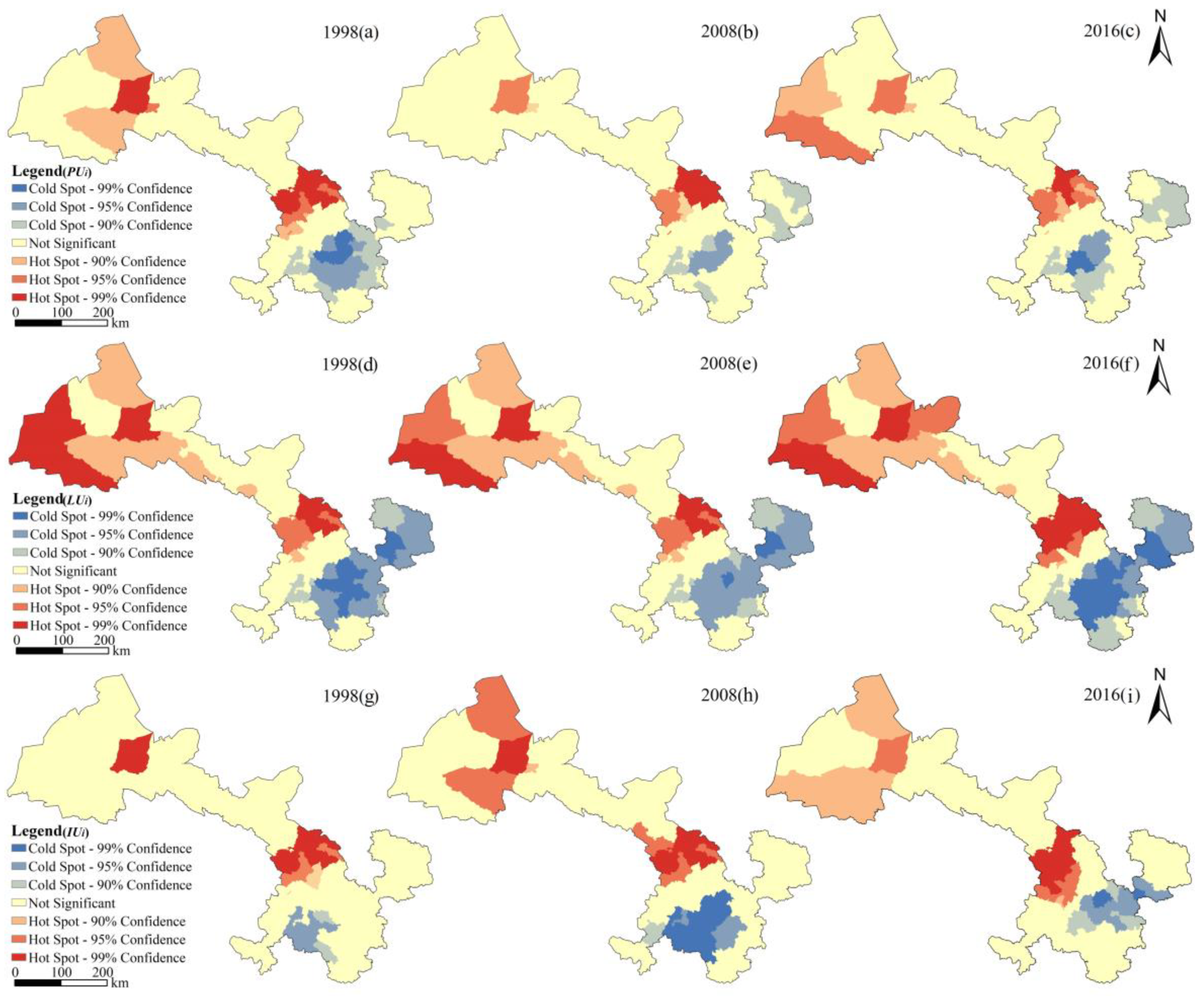
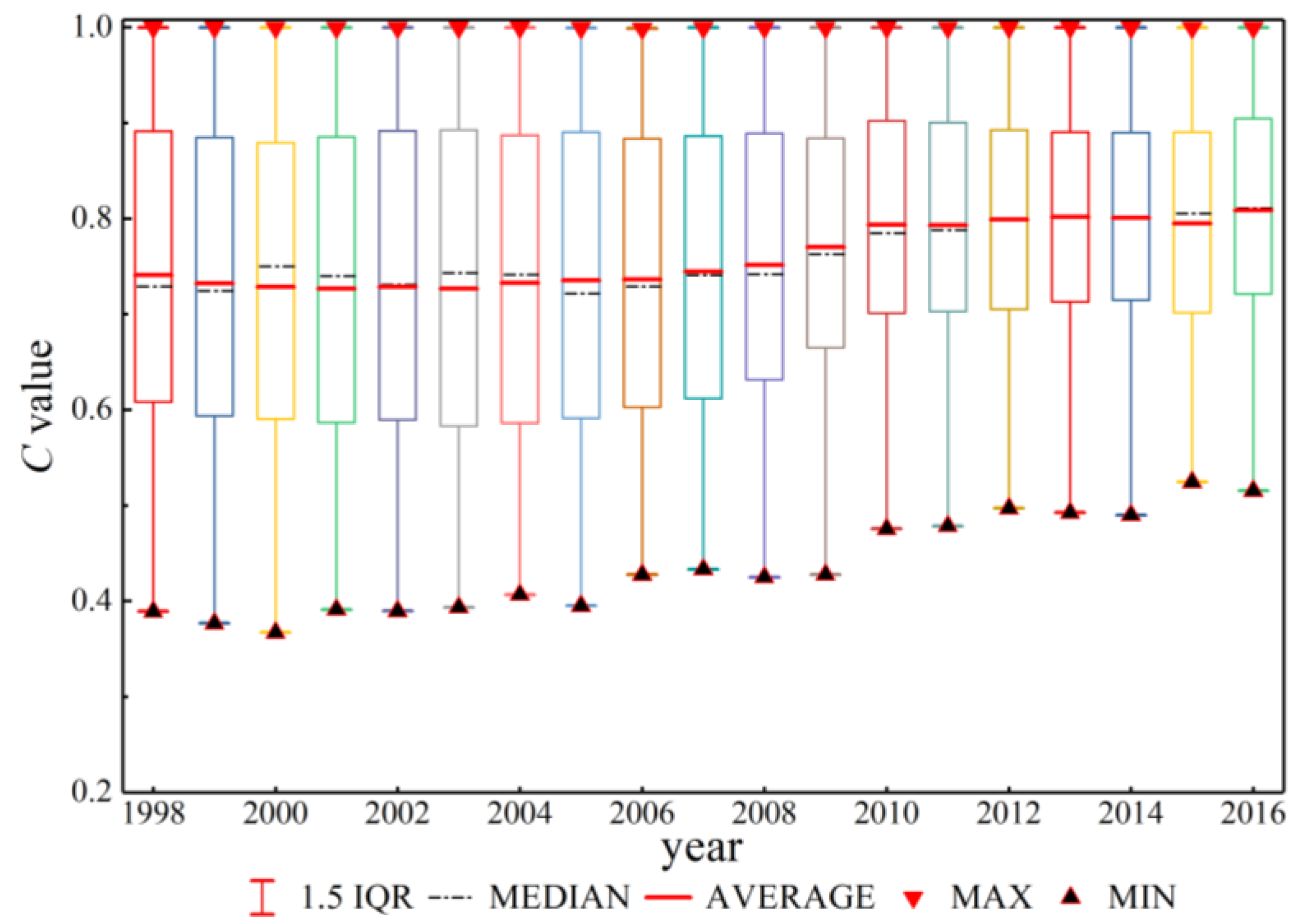

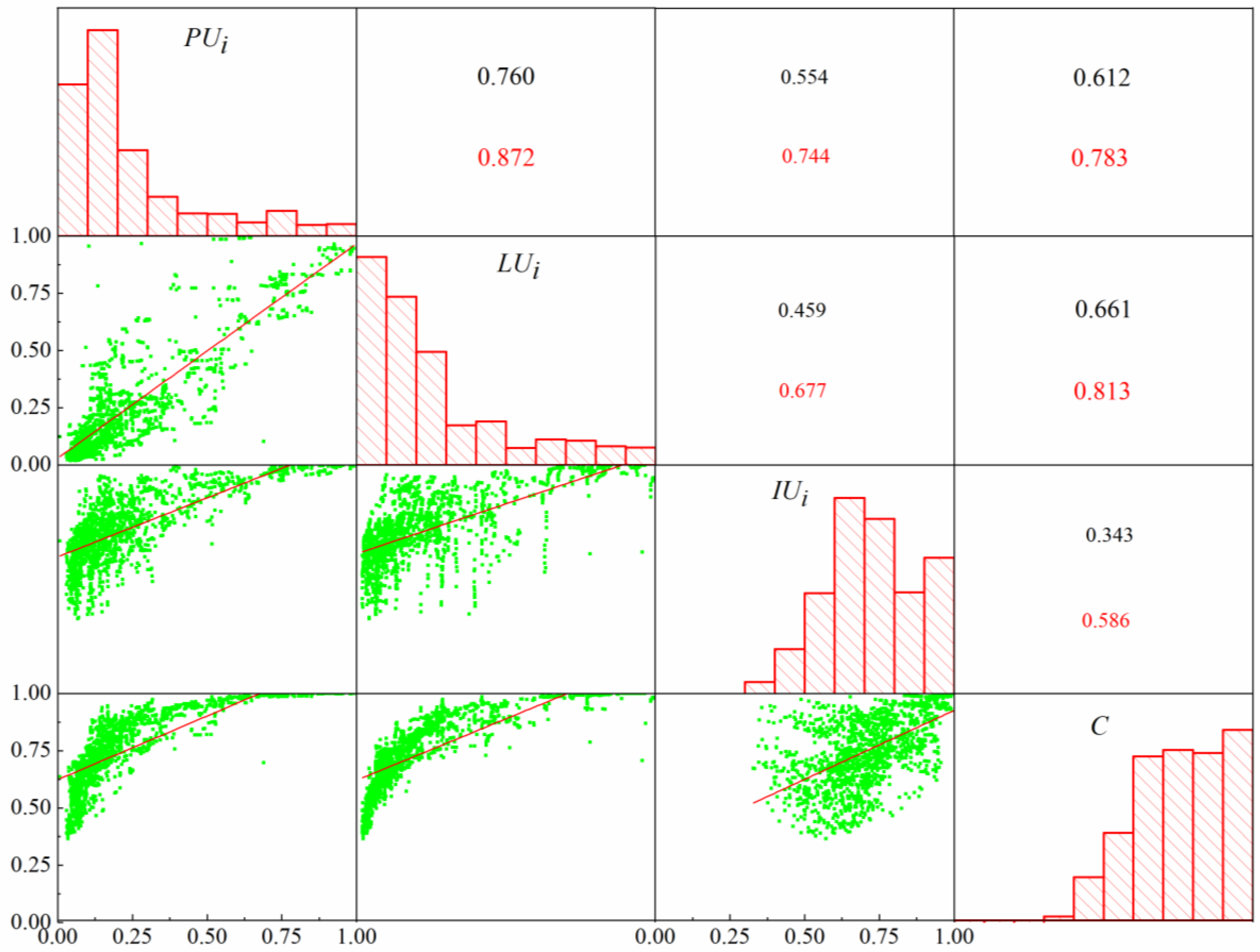

| Urbanization Pattern | Relationship | Connotation |
|---|---|---|
| I | PUi > LUi > IUi | Population structure changes fastest, followed by land structure and then by industrial structure. |
| II | PUi > IUi > LUi | Population structure changes fastest, followed by industrial structure and then by land structure. |
| III | PUi > LUi = IUi | The changes in land structure and industrial structures are comparable and slower than the changes in population structure. |
| IV | PUi < LUi = IUi | The changes in land structure and industrial structures are comparable and faster than the changes in population structure. |
| V | LUi > PUi > IUi | Land structure changes fastest, followed by population structure and then by industrial structure. |
| VI | LUi > IUi > PUi | Land structure changes fastest, followed by industrial structure and then by population structure. |
| VII | LUi > PUi = IUi | The changes in population structure and industrial structures are comparable and slower than the changes in land structure. |
| VIII | LUi < PUi = IUi | The changes in population structure and industrial structures are comparable and faster than the changes in land structure. |
| IX | IUi > PUi > LUi | Industrial structure changes fastest, followed by population structure and then by land structure. |
| X | IUi > LUi > PUi | Industrial structure changes fastest, followed by land structure and then by population structure. |
| XI | IUi > PUi = LUi | The changes in population structure and land structures are comparable and slower than then changes in industrial structure. |
| XII | IUi < PUi = LUi | The changes in population structure and land structures are comparable and faster than the changes in industrial structure. |
| XIII | PUi = LUi = IUi | The changes of population, land and industrial structures are consistent, indicating good coordination among population, land and industrial urbanization. |
| Relationship | Urbanization Pattern | 1998 | 2008 | 2016 |
|---|---|---|---|---|
| PUi < LUi = IUi | IV | 2 | 2 | 1 |
| LUi > IUi > PUi | VI | 2 | 0 | 0 |
| LUi < PUi = IUi | VIII | 0 | 0 | 2 |
| IUi > PUi > LUi | IX | 16 | 31 | 18 |
| IUi > LUi > PUi | X | 18 | 21 | 26 |
| IUi > PUi = LUi | XI | 48 | 32 | 39 |
| PUi = LUi = IUi | XIII | 1 | 1 | 1 |
| Year | Mode | 2008 | |||||||
|---|---|---|---|---|---|---|---|---|---|
| IV | VI | VIII | IX | X | XI | XIII | In total | ||
| 1998 | IV | 0 | 0 | - | 0 | 2 | 0 | 0 | 2 |
| VI | 1 | 0 | - | 0 | 1 | 0 | 0 | 2 | |
| VIII | - | - | - | - | - | - | - | - | |
| IX | 0 | 0 | - | 14 | 1 | 1 | 0 | 16 | |
| X | 1 | 0 | - | 1 | 11 | 5 | 0 | 18 | |
| XI | 0 | 0 | - | 16 | 6 | 26 | 0 | 48 | |
| XIII | 0 | 0 | - | 0 | 0 | 0 | 1 | 1 | |
| In total | 2 | 0 | - | 31 | 21 | 32 | 1 | 87 | |
| Year | Mode | 2016 | |||||||
| IV | VI | VIII | IX | X | XI | XIII | In total | ||
| 2008 | IV | 0 | - | 2 | 0 | 0 | 0 | 0 | 2 |
| VI | - | - | - | - | - | - | - | - | |
| VIII | 0 | - | 0 | 0 | 0 | 0 | 0 | 0 | |
| IX | 0 | - | 0 | 9 | 4 | 18 | 0 | 31 | |
| X | 1 | - | 0 | 1 | 10 | 9 | 0 | 21 | |
| XI | 0 | - | 0 | 8 | 12 | 12 | 0 | 32 | |
| XIII | 0 | - | 0 | 0 | 0 | 0 | 1 | 1 | |
| In total | 1 | - | 2 | 18 | 26 | 39 | 1 | 87 | |
© 2019 by the authors. Licensee MDPI, Basel, Switzerland. This article is an open access article distributed under the terms and conditions of the Creative Commons Attribution (CC BY) license (http://creativecommons.org/licenses/by/4.0/).
Share and Cite
Ma, L.; Chen, M.; Che, X.; Fang, F. Research on Population-Land-Industry Relationship Pattern in Underdeveloped Regions: Gansu Province of Western China as an Example. Sustainability 2019, 11, 2434. https://doi.org/10.3390/su11082434
Ma L, Chen M, Che X, Fang F. Research on Population-Land-Industry Relationship Pattern in Underdeveloped Regions: Gansu Province of Western China as an Example. Sustainability. 2019; 11(8):2434. https://doi.org/10.3390/su11082434
Chicago/Turabian StyleMa, Libang, Meimei Chen, Xinglong Che, and Fang Fang. 2019. "Research on Population-Land-Industry Relationship Pattern in Underdeveloped Regions: Gansu Province of Western China as an Example" Sustainability 11, no. 8: 2434. https://doi.org/10.3390/su11082434
APA StyleMa, L., Chen, M., Che, X., & Fang, F. (2019). Research on Population-Land-Industry Relationship Pattern in Underdeveloped Regions: Gansu Province of Western China as an Example. Sustainability, 11(8), 2434. https://doi.org/10.3390/su11082434






